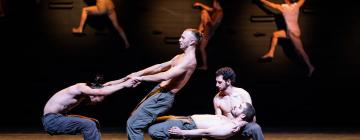Our glossary of musical terms lets you look up any musical term unfamiliar to you, and comes to us courtesy of our good friends at Naxos.
Aubade
An aubade is a morning-song. A well known example is the Siegfried Idyll, a work written by Richard Wagner to be played for his second wife Cosima on the morning of her birthday.
Atonal
Atonal music is music that has no specific tonality, is not in a specific key and therefore has no specific 'home' note or chord. The word atonality refers technically to various forms of 20th century music not in a key.
Assai
Assai (Italian: very) appears often in indications to performers of the speed of a piece of music, as in allegro assai, very fast, or allegro assai moderato, very moderately fast.
Aria
An aria is a song or air. The word is used in particular to indicate formally constructed songs in opera. The so-called da capo aria of later baroque opera, oratorio and other vocal compositions, is an aria in which the first section is repeated, usually with additional and varied ornamentation, after the first two sections. The diminutive arietta indicates a little aria, while arioso refers to a freer form of aria-like vocal writing.
Arco
Arco (Italian: bow) is used as an indication to string-players that they should use the bow, rather than pluck with the fingers (see pizzicato).
Anthem
An anthem is a short vocal composition. In the Church of England the word indicates such a composition often using a non-liturgical text (i.e. not part of the official service). A full anthem is for full choir, without soloists, while a verse anthem makes contrasting use of solo singers. Both these forms flourished in the Church of England from the late 16th century.
Andante
Andante (Italian: walking) is a word used to suggest the speed of a piece of music, at walking pace. The diminutive andantino is ambiguous and means either a little faster or a little slower than andante, more often the former.
Alto
The alto (= Italian: high) is the lower female or unbroken male voice, or male falsetto of similar range. The alto clef (see Clef) is a sign written on the musical stave to show that the middle line of the stave is middle C. It is now used for much of the music written for viola and other instruments of similar range. Female alto soloists are usually described as contralto rather than alto.
Allemande
An allemande is a German dance (the word itself is French) in 4/4 time, often the first dance in a baroque dance suite, where it is frequently followed by a courante, a more rapid dance. The allemande, which appears in earlier English sources often as alman, almain or with similar spellings, is generally moderate in speed.
Allegro
Allegro (Italian: cheerful, lively) is generally taken as fast, although not as fast as vivace or presto. Allegretto is a diminutive, meaning slightly slower than allegro. These indications of speed or tempo are used as general titles for pieces of music headed by instructions of this kind. The first movement of a classical sonata, for example, is often 'an Allegro', just as the slow movement is often 'an Adagio'.
Alla
The Italian alla means 'in the manner of' (= French: la) and may be found in titles like that of Mozart's 'Rondo alla turca', Rondo in the Turkish Style.
Air
Air (= Italian: aria) appearing sometimes with the earlier English spelling ayre, means a tune or melody, for voice or instrument.
Adagio
Adagio (Italian: slow) is an indication of tempo and is sometimes used to describe a slow movement, even when the indication of speed at the start of the movement may be different. The diminutive form adagietto is a little faster than adagio.
Accompaniment
An accompaniment is an additional part for a performer of any kind that is less important than another, which it serves to support and enhance. The piano is often used to provide an accompaniment to a solo singer. In instrumental works for, say, violin and piano the rôles may be reversed.
A
A is the note of the musical scale used generally for tuning (= French, Italian, Spanish: la). Notes in English are given letter names, A,B,C,D,E,F & G.
Arpeggio
The tones of a chord played in rapid succession.
